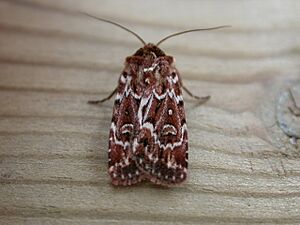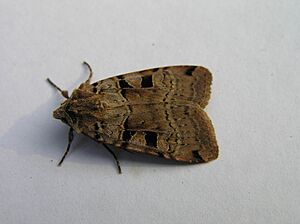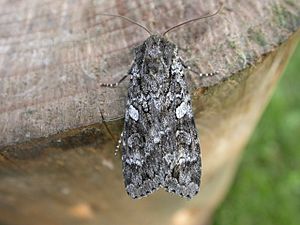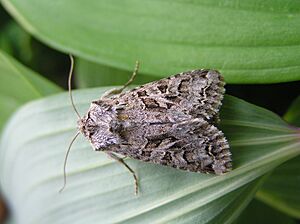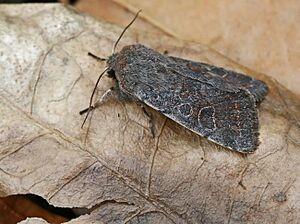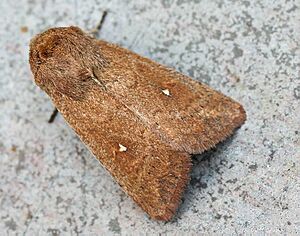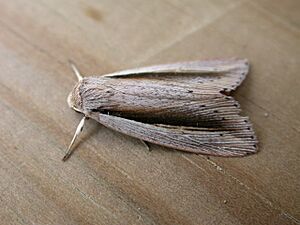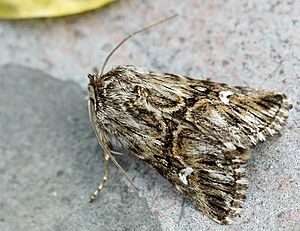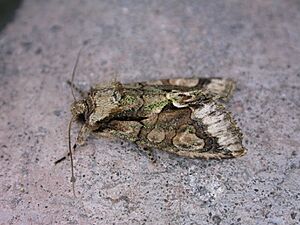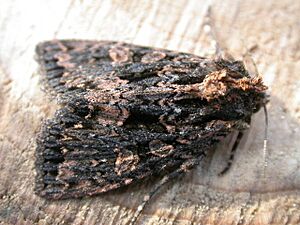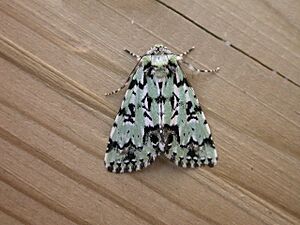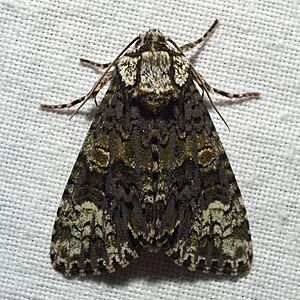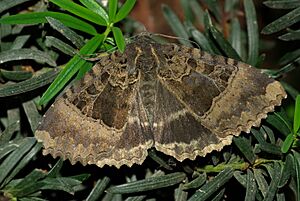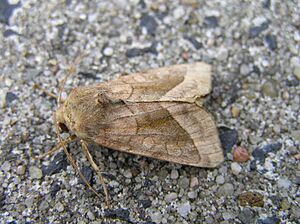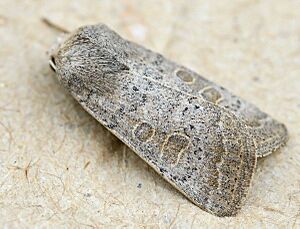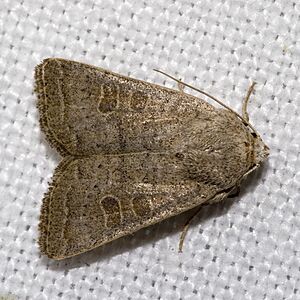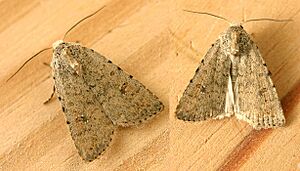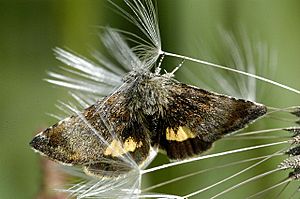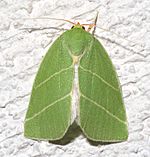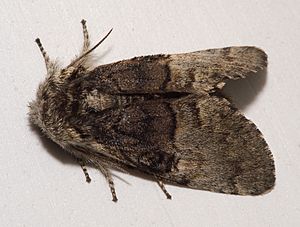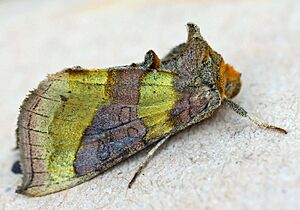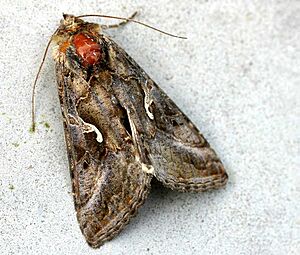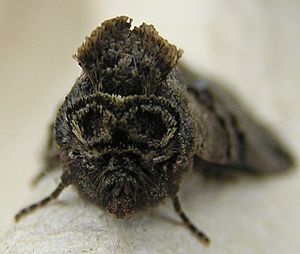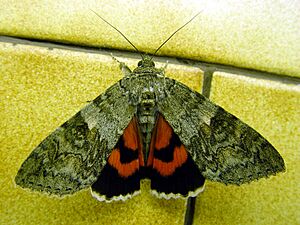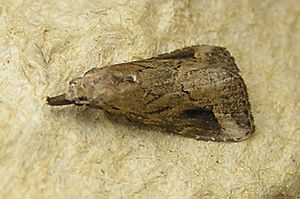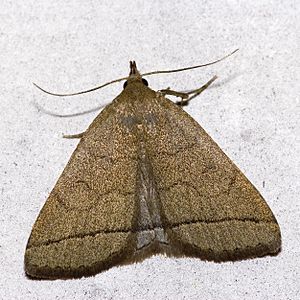List of moths of Great Britain (Noctuidae) facts for kids
The family Noctuidae is the largest group of large moths found in Great Britain. There are more than 400 different kinds of these moths living here! They are often called "owlet moths" because many of them fly at night. You might see them around lights in the evening.
Contents
- Meet the Noctuinae Moths
- Discover the Hadeninae Moths
- Exploring Cuculliinae Moths
- Amazing Acronictinae Moths
- Fantastic Amphipyrinae Moths
- Small but Mighty Stiriinae Moths
- Heliothinae Moths: The Sun Lovers
- Eustrotiinae Moths: Marbled Beauties
- Acontiinae Moths: Rare Sightings
- Eariadinae Moths: Green Peas and Bollworms
- Chloephorinae Moths: Silver and Green
- Pantheinae Moths: The Tussocks
- Plusiinae Moths: The Y-Spots
- Catocalinae Moths: Underwing Wonders
- Ophiderinae Moths: The Heralds and Blacknecks
- Rivulinae Moths: The Dots and Hook-tips
- Hypeninae Moths: The Snouts
- Strepsimananiae Moths: Pinion-Streaked and Oblique-Barred
- Herminiinae Moths: The Fan-Foots
- See also
Meet the Noctuinae Moths

This is a very big group of Noctuidae moths. Many of them have interesting names that describe their look or behavior. For example, the large yellow underwing (Noctua pronuba) is very common and gets its name from its bright yellow hindwings that you can see when it flies.
Some moths in this group are:
- Euxoa tritici, known as the white-line dart.
- Agrotis exclamationis, called the heart and dart, which is found all over.
- Ochropleura plecta, the flame shoulder, also found everywhere.
- Lycophotia porphyrea, the true lover's knot.
- Xestia triangulum, the double square-spot.
Many moths in this subfamily are known for being "darts" or "underwings." Some are also immigrants, meaning they fly to Great Britain from other countries, like the dark sword-grass (Agrotis ipsilon).
Discover the Hadeninae Moths
The Hadeninae subfamily includes moths with names like "shears" and "drabs." These moths are often found in gardens and fields.
Here are a few examples:
- Anarta myrtilli, the beautiful yellow underwing.
- Hada plebeja, known as the shears, which is very common.
- Mamestra brassicae, the cabbage moth, a well-known species.
- Orthosia populeti, the lead-coloured drab.
- Mythimna albipuncta, the white-point, which is an immigrant moth that has recently started living here.
Some moths in this group, like the feathered ear (Pachetra sagittigera britannica), are thought to be extinct, meaning they no longer exist in Great Britain.
Exploring Cuculliinae Moths
This subfamily includes moths with names like "sharks" and "pinions." Many of them have patterns that help them blend in with tree bark or plants.
Some interesting moths from this group are:
- Cucullia umbratica, simply called the shark.
- Shargacucullia verbasci, the mullein, often found where mullein plants grow.
- Calophasia lunula, the toadflax brocade, which is quite rare.
- Xylocampa areola, the early grey, one of the first moths to appear in spring.
- Allophyes oxyacanthae, the green-brindled crescent.
Sadly, some moths like the cudweed (Cucullia gnaphalii occidentalis) and the beautiful arches (Blepharita satura) are also presumed extinct in Great Britain.
Amazing Acronictinae Moths
Moths in the Acronictinae subfamily often have names like "chestnut" or "dagger." They can be quite colorful or have unique markings.
Here are some examples:
- Eupsilia transversa, the satellite.
- Conistra vaccinii, the chestnut, a common moth.
- Agrochola circellaris, the brick.
- Xanthia citrago, the orange sallow.
- Acronicta psi, the grey dagger, found all over.
- Craniophora ligustri, the coronet.
The scarce merveille du jour (Moma alpium) is a very rare moth in this group.
Fantastic Amphipyrinae Moths
This is another large and diverse subfamily. You'll find moths with names like "underwing," "rustic," and "wainscot" here.
Some well-known moths include:
- Amphipyra tragopoginis, the mouse moth.
- Mormo maura, the old lady, a large and striking moth.
- Phlogophora meticulosa, the angle shades, which has a unique wing shape.
- Cosmia trapezina, the dun-bar.
- Apamea monoglypha, the dark arches, a very common moth.
- Oligia strigilis, the marbled minor.
- Hydraecia micacea, the rosy rustic.
- Hoplodrina blanda, the rustic.
- Paradrina clavipalpis, the pale mottled willow.
Some moths in this group, like the union rustic (Eremobina pabulatricula), are now extinct. Others, like the Brighton wainscot (Oria musculosa), are very rare.
Small but Mighty Stiriinae Moths
This smaller subfamily includes moths like the small yellow underwing (Panemeria tenebrata). This moth is often seen flying during the day, which is unusual for a Noctuidae moth!
Heliothinae Moths: The Sun Lovers
Moths in the Heliothinae subfamily often fly during the day and are attracted to flowers. Their names sometimes include "clover" or "straw."
Examples include:
- Pyrrhia umbra, the bordered sallow.
- Helicoverpa armigera, the scarce bordered straw, which is an immigrant moth.
- Heliothis peltigera, the bordered straw.
Eustrotiinae Moths: Marbled Beauties
This subfamily features moths with "marbled" in their names, referring to their patterned wings.
- Protodeltote pygarga, the marbled white spot.
- Deltote uncula, the silver hook.
Acontiinae Moths: Rare Sightings
This group includes moths like the spotted sulphur (Emmelia trabealis), which is now presumed extinct in Great Britain. The pale shoulder (Acontia lucida) is an immigrant moth.
Eariadinae Moths: Green Peas and Bollworms
This subfamily has moths with interesting names like "green pea" and "bollworm."
- Earias clorana, the cream-bordered green pea.
- Earias insulana, the Egyptian bollworm, which is a rare immigrant.
Chloephorinae Moths: Silver and Green
This subfamily includes moths with "silver-lines" in their names, often referring to their wing patterns.
- Bena bicolorana, the scarce silver-lines.
- Pseudoips prasinana britannica, the green silver-lines.
Pantheinae Moths: The Tussocks
The Pantheinae subfamily includes moths like the nut-tree tussock (Colocasia coryli), which is found throughout Great Britain.
Plusiinae Moths: The Y-Spots
This subfamily is known for moths that often have a metallic sheen or a Y-shaped mark on their wings.
- Diachrysia chrysitis, the burnished brass, which looks like it's made of shiny metal.
- Autographa gamma, the silver Y, a very common immigrant moth that can be seen flying during the day.
- Autographa pulchrina, the beautiful golden Y.
- Abrostola tripartita, the spectacle, named for the markings on its head that look like glasses.
Catocalinae Moths: Underwing Wonders
The Catocalinae subfamily includes the famous "underwing" moths, known for their brightly colored hindwings that flash when they fly.
- Catocala nupta, the red underwing, a large and beautiful moth.
- Catocala fraxini, the Clifden nonpareil, a large immigrant moth.
- Catocala promissa, the light crimson underwing, a rare moth.
- Callistege mi, the Mother Shipton, named for a pattern on its wings that looks like a witch's face.
Ophiderinae Moths: The Heralds and Blacknecks
This subfamily includes moths like the herald (Scoliopteryx libatrix), which is known for its long lifespan and ability to hibernate.
- Lygephila pastinum, the blackneck.
Rivulinae Moths: The Dots and Hook-tips
This group includes smaller moths.
- Rivula sericealis, the straw dot, a common moth.
- Laspeyria flexula, the beautiful hook-tip.
Hypeninae Moths: The Snouts
Moths in the Hypeninae subfamily are often called "snouts" because they have long, forward-pointing mouthparts that look like a snout.
- Hypena proboscidalis, the snout, a very common moth.
- Hypena crassalis, the beautiful snout.
Strepsimananiae Moths: Pinion-Streaked and Oblique-Barred
This subfamily includes moths like the pinion-streaked snout (Schrankia costaestrigalis).
Herminiinae Moths: The Fan-Foots
Moths in the Herminiinae subfamily are often called "fan-foots" because of the feathery scales on their legs.
- Zanclognatha tarsipennalis, the fan-foot, a common moth.
- Herminia grisealis, the small fan-foot.
Some moths mentioned in this article are part of the UK Biodiversity Action Plan (BAP). This means they are special species that need extra help and protection to make sure they survive and thrive in Great Britain.
See also
- List of moths of Great Britain (overview)
- Family lists: Hepialidae, Cossidae, Zygaenidae, Limacodidae, Sesiidae, Lasiocampidae, Saturniidae, Endromidae, Drepanidae, Thyatiridae, Geometridae, Sphingidae, Notodontidae, Thaumetopoeidae, Lymantriidae, Arctiidae, Ctenuchidae, Nolidae, Noctuidae and Micromoths





